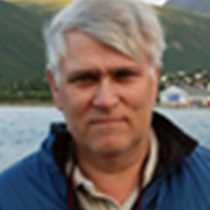Barent Sea, Bjørnøya
In the morning we were steaming rapidly south through a large ocean, the Barent’s Sea. Once in a while large whale spouts were to be seen in the distance and we did make the effort to approach a large baleen whale. Some claim it was a Fin Whale others would go for a Sei Whale it shows that whale identification sometimes can be a challenge!
A huge long easterly swell made the ride very pleasant and through the morning we also enjoyed several presentations, birds in the area and more photography lessons.
At about lunch time we approached a single isolated island in this large ocean, Bjørnøya. This desolated outpost is located as the warm northerly Gulf Stream and a cold westerly Siberian current meet. As the cold meets warm it is very often clogged in with fog and gives the island a very dramatic setting. Bjørnøya is also more or less the very southern point for sea ice to reach in late winter and in fact during late winter polar bears are sometimes seen.
The island is surrounded by one of the most productive oceans in the world. Life is steaming and the southern part of the island, with huge cliff faces, is home to about one million seabirds, kittiwakes, fulmars, thick-billed murres, common murres, puffins…
As the swell did not make it possible to use our regular anchor site at Sørhamna, in the southeast, we sailed around to the western side to gain protection for the swell. Here we also found one of the few places you actually can get ashore, at Kapp Harry, as the whole island is surrounded by high cliffs. A scouting boat was sent out to pre-arrange the landing site.
After lunch we dedicated the whole afternoon to exploring a piece of this true wilderness. The island is set aside as a nature sanctuary, but at the northern most tip, you find a small Norwegian radio and metrology station manned all year by 9 hardy Norwegians.
Our hikers did not make it this far and instead we explored the flat land above the sea cliffs and reached the lake, Ellasjøn. Others were making adventures Zodiac cruising along the cliff walls. 10,000s of newly fledge kittiwakes swarmed over our heads and we made it into caves and through arches. Most of the Zodiacs went south to make a turn around Sylen (the Neddle) standing alone 75 meters tall! The cold northeasterly wind did add to the adventure and for sure it was nice to get back onboard the cozy warm ship.
Being one of the richest areas of ocean in the world, which all of the seabirds indicate, we also launched two more Zodiac boats with a totally different mission, to fish! The cod population in the Barent’s Sea is still healthy and has for the last 25 years been monitored and managed by the Norwegians. In fact as we were approaching our anchor site we saw several trawlers using the protection of the island to off load their catches to freezer ships. At the same time we also saw the Norwegian Coast Guard ship, Svalbard, on patrol. The fisheries here in the Barent’s Sea are intense and daily flights are also made by Coast Guard patrol planes to keep an eye. Cod is of course the main prey but other important fisheries are herring, halibut, capelin and blue whiting. The later two are mainly processed for fish powder to feed salmon farms, chicken food…
How did our cod fishery go? With hand lines the hotel manager and his team was able to get enough to promise us freshly fished cod on the dinner menu for tomorrow. Here is our happy head chef Daniel Carijn with his catch of the day. Bjørnøya is for sure an amazing place to visit.



